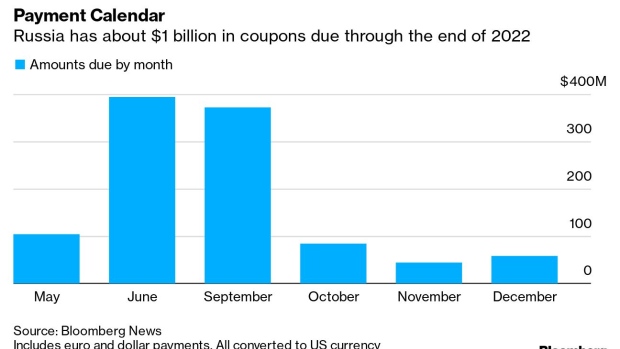May 26, 2022
Russia Faces Biggest Debt Test Yet as US Payment Ban Clouds Path
, Bloomberg News

(Bloomberg) -- The path for Russia to keep sidestepping its first foreign default in a century is turning more onerous as another coupon comes due on the warring nation’s debt.
Investors are supposed to receive about $100 million worth of interest on Russian foreign debt in their accounts by Friday, payments that President Vladimir Putin’s government says it has already made. That’s unlikely to satiate concerned bondholders who are itching to see the cash after the US Treasury closed a loophole that previously allowed US banks and individuals to accept such payments.
It’s the latest twist in a debt saga that has dragged on for months as the war in Ukraine and sanctions complicate the flow of cash from Russia to holders of its foreign debt. If Russia’s obligations aren’t fulfilled, a 30-day grace period ensues.
“We are in uncharted waters,” said Ehsan Khoman, head of emerging market research at MUFG Bank Ltd. in Dubai. “All eyes are now on May 27.”
Russia last week said it met its obligation on the bond payments by transferring the money to the National Settlement Depository, or NSD, the main central securities depository in Moscow.
By Friday, investors are supposed to receive $71.25 million in interest on debt maturing in 2026 and 26.5 million euros ($28.4 million) on bonds maturing in 2036.
The contractual terms of the notes state that NSD is the registered holder of the bonds for the purpose of making principal or interest payments, meaning that Russia could argue it has fulfilled its responsibility to pay even before the funds are officially sent to individual investor accounts.
That could allow Russia to potentially avoid a default situation tied to these payments, even if they don’t reach bondholders.
The transfer to NSD came just days before a temporary exemption for US bondholders to receive Russian bond payments expired. Without the carve-out, US individuals are barred from accepting debt payments from Russia’s government.
In the case that a payment isn’t completed, Russia then has a grace period of up to 30 days to find a solution, such as it did in early May, when it got money to investors at the very end of that extended period after payments were initially blocked.
Without elaborating, the nation’s foreign minister said on Thursday that there are plans to offer a new tool for bondholders that would allow them to receive principal and interest on Russia’s foreign debt. Russia’s Finance Ministry has also said it would make payments in rubles.
Risk Remains
Despite the technicalities, there’s little doubt that Russia is still at risk of sliding into its first external bond default since the aftermath of the 1917 Revolution, when the Bolsheviks refused to recognize the czar’s debts. Russia’s late-1990s default was on domestic debt.
Swaps are currently pricing in an 87% chance of a Russian sovereign default within a year, according to ICE data services.
Some focus has also shifted to the outcome of a review by the Credit Derivatives Determinations Committee, a panel of dealers and investors that is assessing whether a default may have already occurred when Russia failed to include $1.9 million in extra interest on a payment made earlier this month.
“Typically, default on sovereign debt is related to the government’s inability to pay due to a lack of available funds,” said Darshak Dholakia, a partner at Dechert LLP. “Here, Russia is able and willing to make payments, but nevertheless could be declared to be in default due to an inability of bondholders to accept payments and of banks to process payments.”
©2022 Bloomberg L.P.





